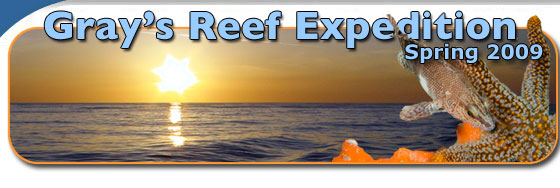Error processing SSI file
|
Gray's Reef Expedition
Log Day 7: June 14, 2009
By Dr. Laura Kracker
Geographer, NOAA
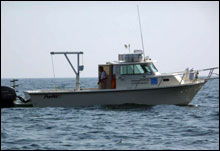 |
| SkIO Explorer. (Photo: Dr. Laura Kracker)
|
With so many projects occurring at the same time, operations on the Nancy Foster can be quite a juggling act for both crew and scientists. On Thursday, Victoria Price (Tori) and I transferred from the Nancy Foster (affectionately known as the ‘mother ship’) to the Explorer operated by Captain Jay Fripp of the Skidaway Institute of Oceanography. We ran a high resolution sonar and video survey at one of the dive sites. This sonar and video equipment was deployed over the side of the Explorer and placed on the ocean bottom at the dive site. The sonar captured images of fish near a ledge feature that the dive team had surveyed the previous day. We are using these sonar images, along with the diver observations to look for predation events linking the mid-water and bottom reef fishes. Dr. Auster suspects that this type of predator-prey behavior might be an important ecological link as mid-water predators drive prey fish into the reef habitats of piscivorous fish below.
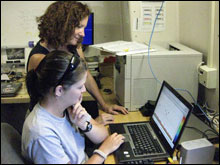 |
| Dr. Laura Kracker and Victoria Price examining Biosonics data. (Photo: Greg McFall)
|
A related project uses a second type of sonar, called fisheries acoustics, to map fish distribution in mid-water and reef habitats on a larger scale. The fisheries sonar transducer is attached to the hull of the ship and can be used to cover a much larger area or concentrate on a specific location. The fisheries sonar produces an echogram showing the location and intensity of fish in the water column – or pelagic zone. We have been running these acoustic surveys at night across the entire sanctuary and during the day around the dive sites. We will use this information to estimate fish abundance over different bottom habitats and to examine patterns over the entire Sanctuary.
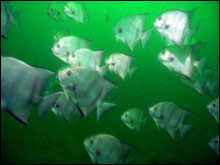 |
| Atlantic Spadefish. (Photo: Dr. Peter Auster)
|
By using a combination of sampling methods, schools of fish (Atlantic Spadefish, see photograph) observed by the dive team can also be seen at a broader scale with the fisheries acoustics survey (see figure of acoustic echogram showing fish above the reef). One of the most valuable aspects of a cruise like this is the exchange of ideas and research data that allows scientists a chance to view the world from a different perspective.
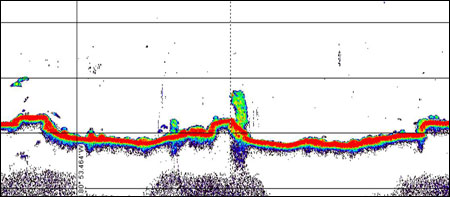 |
| Acoustic echogram. (Credit: Dr. Laura Kracker)
|
|

